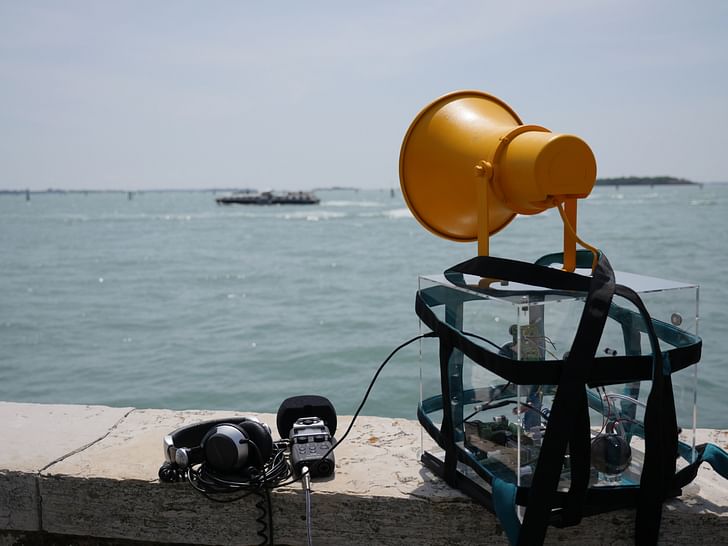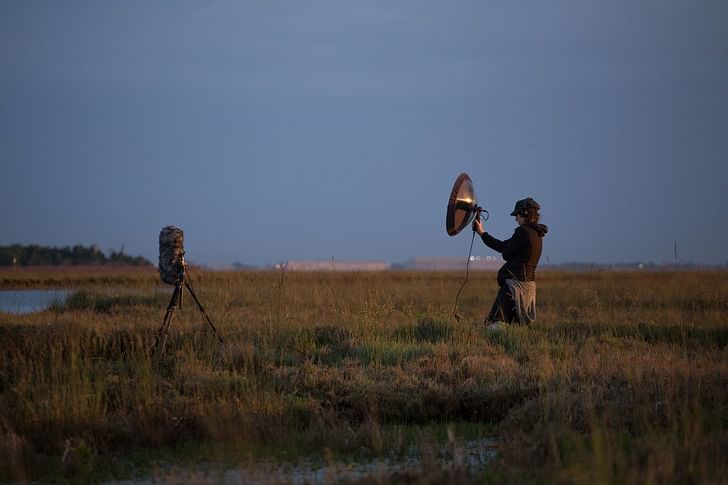

Though Venice has been the home of the eponymous Biennale since 1895 and the site of Western trade since roughly 400 AD, its longer history as a swamp is often overlooked. Its parcel of land and sea in Northeast Italy is notably hot, humid and rife with mosquitos, and has been since time immemorial. The ecosystems that depends on its swampy soil and vapor are threatened by human settlement, which has made it one of the most popular tourist destinations in modern history.
The Swamp Pavilion, Lithuania's contribution to the 2018 Venice Biennale, is a networked effort to highlight the intersection of human and natural history present in Venice in the middle of what is commonly referred to as the 'Anthropocene.' Organized by Gediminas Urbonas and Nomeda Urbonas, the Swamp School has developed new theories and pedagogies in the format of a 'school,' through public interventions, field trips, workshops, lectures, discussions, chat channels and printed publications.
Its first of three installments, Swamp Radio, ran from May 23rd to the 27th and was primarily invested in engaging participants in acoustic space explorations, radio experiments, environmental sound recordings and data sonification. Through the power of sound, its organizers argue, the presence of the city's non-human entities can be more sensitively and apparently felt. The following is a selection of events from the Swamp Pavilion's first installment.
The first day kicked off with a series of excursions to the outskirts of the Venetian terrain, where the term 'swamp' could be felt by its more sensorial characteristics. Nicole L'Huillier, a PhD Candidate at MIT's Media Lab, opened up a dialogue concerning the possibilities of re-thinking radio communication as an open tool for transmitting and receiving as a means of creating streams for civic communication, engagement and expression. By teaching participants about how radio can act as an invisible and mobile architecture, L'Huillier brought the 'school' to a nearby Venetian canal to collect audio.

Jana Winderen began her field trip to a nearby swampland at 4 in the morning, both to collect audio before the nearby city could interrupt its sound waves as well as to enact her own form of morning mediation for the program's participants. Her workshop was an exercise in hearing and listening with the whole body in an effort to connect physically to the world and the swampland through sound vibrations received through bone conductions and other means. The sensitivity gained in this exercise recalled the concept of "invisible architecture" developed by the architect and artist Juan Downey, suggesting that the traces of certain 'walls' and other physical demarcations can only be made tangible through intense sensory focus.
Sam Auinger ran a series fo workshops focusing on the "sonic commons" of historical Venice and the city's connection to the swampland it was built on. Inviting participants to wade knee-deep through the mud of a nearby swamp, Sonic Commons pursued a strategy of "active listening" to create auditory access to the world with all its sonic information by both developing a practical understanding of how the gift of hearing is created and addressing the difference between acoustic properties and auditory qualities.
For their lecture, the founders of Design Earth (Rania Ghosn and El Hadi Jazairy) presented work from their new book, Geostories: Another Architecture for the Environment. Their illustrations attempted to make sense of the Earth at a moment in which it is "presented in crisis." At a time in Venice's history when its human and natural histories are threatening each other in a tumultuous present, Geostories provided a manifesto on the environmental imagination that renders sensible the issues of climate change as well as a geographic fiction that invited the audience to relate to the "complexity of Earth systems in their vast scales of time and space."
A walking tour was conducted by Petteri Nisunen and Tommi Grönlund, two partnering artists based in Helsinki. Participants explored Venice in search of sonically interesting sites and spaces within its cavernous walkways and canals. The next day, a workshop was held in which the sound files recorded from the previous day were compiled into a sonic map intelligible to its participants. Through these audio files, Nisunen and Grönlund argued, the auditory presence of Venice was given precedent beyond the typically visual or olfactory qualities that have granted Venice unique touristic status.
A joint lecture was then held by Beatriz Colomina and Mark Wigley, both of which outlined material on the subject of the distribution of media in the 21st century. Colomina, the current Director of the Ph.D. Program at Princeton University's School of Architecture, introduced her current research project, Broadcasting Yourself: Social Media Urbanism, with a provocative statement: "Social media is the ultimate space for design. Through its multiple platforms, we not only communicate and collaborate with wide and wider groups but also refashion ourselves." Colomina's lecture further argued that social media can structure the built environment and that we currently inhabit a hybrid of physical and virtual reality when performing even the most routine tasks. By treating social media as a "new urban condition," Colomina posited that it can also play an influential role in contemporary forms of social and environmental activism.
Mark Wigley, Professor and Dean Emeritus at Columbia GSAPP, listed off some startling facts about the insect kingdom: insects make up 50 percent of animal life on the planet and 90 percent of its biodiversity. "They have lived million of years longer than the recently arrived human species," Wigley mused, "and will do so long after we depart." Wigley then argued that the secret of their success "their signature pair of antenna, with which they negotiate the world and each other." Their antennae, in other words, form an advanced network of communication that helps them thrive on a planet quickly being shaped by human activity.
3 Comments
I'm going to selfishly (see also "This isn't so much a question but a comment..." LOL) take this post to pimp a project by Brian McCutcheon, my husband.
Water Mine is an interactive sculpture built to collect and amplify the underwater sounds of the Virginia B. Fairbanks Art & Nature Park lake at the Indianapolis Museum of Art. Through the sculpture visitors experience underwater soundscapes that are broadcast into the open air. The piece features project collaborators Michael Drews and Jordan Munson performing on a boat - a live musical response to the sculpture broadcasts using amplified water and electronic sounds. The specially outfitted boat and speaker truck were launched at various intervals during the Autumn Equinox event.
Kids loved throwing in a pebble and hearing the sound.
That's so cool. Are there any video or audio recordings available?
So much to discuss. Like the highly derivative, non-sited "Bugs" of ACT, I am profoundly confounded by the word choice: "Swamp". To my mind the word has NO positive connotation, referencing the derogative swindling notions of Florida Real Estate salesmen vis a vis David Mamet's Glengarry Glen Ross, the oxymoronic use of the word to basically formalize the destruction of democratic institutions through greed, gross self-interest,and the complete disregard for both the cultural, scientific and large scale understanding of the criticality of what we now consider THE MARSH, the essential birthplace of all life. If we cannot be honest through the deteriorating landscape of language to even describe our world, including our fascinations with all of the elements that make up that world, (Like sound) then we continue down a rabbit hole where disrespect continues to rule the day. When Richard Lerman, former CAVS fellow was using piezo-electrics to amplify the most subtle of things like the delicate strands of the spider web as an integral element of sound works back in the mid-to late eighties, he was creating ( playfully) through technology artwork that illuminated our natural world bringing our ears to the scale of the Arachnid. He did the same with his collaborator Tom Plesik, a trombonist who together through the performance venue, Moebius, and with the help of the R.V. Harold Edgerton and some sound filters and hydrophones played "whale songs" near the canyons of the George's Bank, bringing right and minke whales to the surface, whom I am sure must have thought "why are these humans swearing at us?". Even Alan Berger the Leventhal Professor of Advanced Urbanism at the MIT SAP, who coined the concept of "Systemic Design" has been working to change this word from SWAMP to Marsh through the civic-scale resuscitation of these vital natural flushing systems long disregarded as "worthless". Maybe the use of SWAMPS and BUGS is an attempt to be provocative, but it is wrongheaded, mindlessly confrontational and I would posit sloppy. Changing our perceptions of the "otherworldliness" of underwater environments again, has its history, (Jürgen Claus, Uriel Levi, Julie Gauthier, Les Ateliers Claus) and has a profound need for reclamation. (our own innerspace, where astrobiologists explore our deep oceans's toxic environments)--All of these are part and parcel of a world view developed long ago by Buckminster Fuller, and has active proponents in Newton Harrison and his recently late wife/partner Helen, not to mention David McConnville, of the Buckminster Fuller Institute. McConnville's fabulous lecture at Concordia University in Montreal (2017)and soon at Woods Hole presented by THE DOME at Woods Hole, called "REGENERATING THE ECOLOGICAL COMMONS", touches exactly on COMMONISM, and the criticality of being cognizant of the history of these pursuits. I hope you will take the time to recognize these in your work.
Block this user
Are you sure you want to block this user and hide all related comments throughout the site?
Archinect
This is your first comment on Archinect. Your comment will be visible once approved.